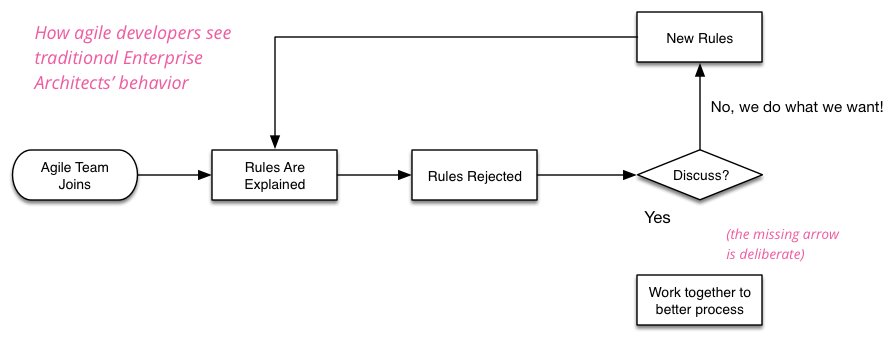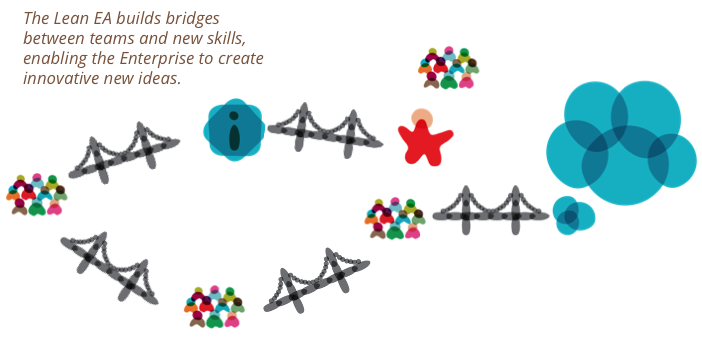The Role of an Enterprise Architect in a Lean Enterprise
30 November 2015
If you are an Enterprise Architect (EA) in an organization transitioning to lean or agile practices, you may be feeling a bit lost. You have worked hard to get where you are. You probably wrote most of the critical system software keeping your enterprise running. You helped implement and maybe even designed the architecture. You know some of it is older technology and a bit fragile, but with too few resources and too little time, compromises have to be made. In fact, your own ability to keep up with the latest trends have suffered because only you know how to keep things working. To help manage time, you have implemented universal standards and tried to funnel requests to architecture review boards or other planned meetings. Developers routinely work around the system, complaining that process holds them back, but you know that these things are there for the good of the company so you reinforce the policy to try to keep control.
Now, new leadership or a consulting firm arrives and declares that the organization is “becoming agile”. The developers read this as a mandate to do whatever they want in the name of agility and flexibility. They start to treat you like a relic of the past and subvert or ignore you. They introduce practices and technologies that risk destabilizing the infrastructure or failing at a critical moment. You know that the business needs you to do your job, but you feel like everyone is working against you.

The truth is that they need your job to be done, perhaps more now than ever. That job is to use your knowledge and experience to minimize risk, manage cost, build capability in IT and align the technology mission with the business. The mission remains the same, but the way to go about it is a bit different. Both Lean and agile focus on value creation, waste reduction and rapid feedback, so you will need some new practices to be successful in these new environments. The new toolbox includes sharing a simple vision, building bridges, aligning the business, and providing guidance, all in an effort to promote innovation.
How to get there
Overall, this is a shift from the traditional practices of the EA and architecture team. Instead of a centralized EA group making decisions for the development teams, you are now an influencer and aggregator of information. Your role is no longer to make choices, but to help others make the right choice and then radiate that information. Doing this requires some new tools and techniques. Following are some ideas on how to act in this new role. All of them are high level and do not all apply to every organization. The goal is to be nimble and responsive to the needs of the teams you support; experiment with some techniques, measure their effectiveness, keep the ones that work and pivot on the ones that do not.
Build bridges
Once you have a vision, you want to see it come to life. But since you and your team are not developing or managing projects, how can you make this happen? The best way is become a partner and resource for the development teams. Your purpose is not to limit or block progress but instead to enable it. When a development effort is starting, reach out to the technical and project leadership. Offer them a refreshed view of the target enterprise architecture and discuss how their project can enable that vision. Often times teams are engaging in work that is similar to other ongoing or completed projects in the enterprise. Make sure that they are aware of these projects so that they can leverage anything from shared experience to actual code and artifacts. Try to avoid getting mired in the details of the implementation; do not worry about what libraries or versions are going to be used. Focus instead on the high-level goals and design of the project and how it aligns to the overall vision.

When discussing projects, inevitably technology choices will come up. Most of the time teams are content to use similar technologies to other projects in the enterprise. Occasionally, however, technologists learn about a new technology and want to use it to solve their problem. Avoid the temptation to immediately say no or assume that they are selecting the new tool just because it is new and fun. While that can and does happen, new tools are created to solve problems and it might just be the right time to move forward. Discuss the choice with the technology team to determine if they have a good argument for using the new technology. Make sure they understand the cost and difficulty of bringing a new platform to production and that the benefits outweigh this cost. You may have to listen for a bit then do some research before finishing the discussion. Consider doing a time-boxed proof-of-concept with real measurements and boundaries to determine the feasibility. If, in the end, the new technology is not the right choice, try to gain consensus from the developers or their leadership. Avoid making it a mandate if at all possible. This will help generate good will with the development teams and ensure that they will include you in future decisions. When experimenting with new tools or technologies, limit the number of experiments ongoing in the enterprise at any one time. It will be hard to measure the effects accurately with too much simultaneous change.
Ultimately, success as an EA is only made possible with the support of the development teams. If you treat them like subordinates they will find ways around you and put your vision and strategy at risk. You will still be held accountable for the outcomes with little ability to change them. If, instead, you treat them as partners they will help you realize your vision and everyone will get to be successful. Embrace change but measure it and make sure that everyone understands the value of the change. Ultimately, always try to guide teams to the vision of the enterprise architecture.
Find Opportunities for Change
Big change takes time and opportunity. Once you have your vision for the future and start to build excitement within the enterprise, you will want to see results immediately. It is important to keep in mind that big changes in architecture need to come gradually and at the right time. Use existing projects in the portfolio to start the process of change. Guide new implementations to move toward the architectural vision. Keep in mind that opportunities to change code and move in the desired direction may not come at the speed or in area that you want them to. Learn to celebrate the victories, however small, and stay vigilant for chances to make positive change.
That being said, work with the business to prioritize projects that address the worst parts of the existing portfolio. Business leaders rarely understand the value of changing technical components nor the cost of maintaining the status quo. When purely technical changes are warranted, it will fall to you to create opportunities to change them. Make sure to frame the change in terms of value to the business in future savings offsetting the cost to implement or in terms of risk reduction. If necessary, find a partner in a business function and create a project that both adds new business value and enables a change in architecture. Seek opportunities to retire old applications and hardware that are a drag on the budget and operations teams.
Patience with the pace of change will help avoid frustration. Remember that change can only happen within the context of ongoing work, so make the most of the projects in the budget and portfolio. Create opportunities by identifying new projects that will generate new value for the business or save more money than the cost of development. Keep in mind that generating business value is your primary goal, so avoid purely technical projects that are interesting but not valuable. As the business sees increased production and value from following your vision, momentum will grow and the pace of change will increase. Until it does, keep shaping the work and refining the vision.
Build a Community of Learning
In addition to having a vision for the overall enterprise architecture, it falls to the EA to see that vision executed with the right skills and practices. While each development team will develop the skills it needs to succeed, sharing the best skills and practices across different teams will help each of them execute better and have a shared sense of purpose. As the bridge between teams, you are best suited to fostering this sense of community.
Building community can be done a variety of ways, from informal lunches to 3rd party training. Rather than try to determine what will work for your organization, form a group of technologists from tech leads to developers who are passionate about their craft and let them help. Have the team meet on a regular cadence to plan events. Make sure to build in some time for development teams to share what they have learned - both what has been successful and what they have rejected. Having a chance to share with the whole IT organization will start to build the sense of community that will result in a healthy organization.
Avoid forcing people to attend training and learning activities. Make them open to all but optional. People who are not interested will be a distraction either by acting out or appearing bored, demoralizing the presenter. Those who are passionate will welcome the chance to learn and grow; those who are not will not benefit from required attendance.
A sense of a community and opportunities to learn will energize developers and promote retention. By leading the core of the community, you can guide the development of your organization in alignment with your vision for its future. Allowing others to participate in this guidance will identify and build leadership from within. A strong sense of pride and community will lead to better quality and more collaboration.
One day at a time
Change is neither easy nor fast. Moving to a new set of practices will take time and effort, but will be worth it in the end. When your teams are creating value together and the business sees IT as a partner instead of a burden it will all be worth it. Remember that to be an EA in a Lean Enterprise is to build relationships between development teams and the business. Create a vision and guide development toward it. Be broad, not deep. Help developers invest in themselves. Experiment wisely. Most importantly, enjoy yourself, learn new things, create value and turn your organization into an industry leading innovator.
Significant Revisions
30 November 2015: First published

